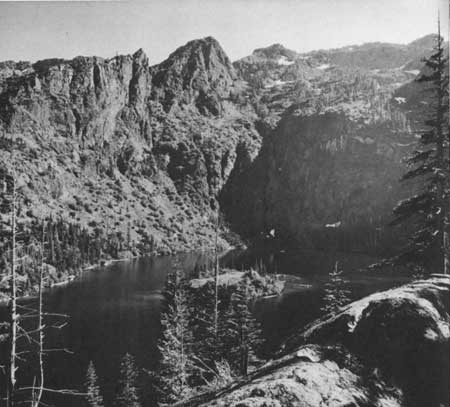|
OLYMPIC National Park |
 |
Glaciers Today
A glacier is an accumulation of ice large enough to move of its own weight. Mountain glaciers form at high altitudes where snowfall exceeds melting and the snow builds up annually until, largely due to its weight, the lower layers become solid ice. When the depth of this ice becomes great enough—100 feet or more—it will flow down slope and the ice is transported to lower altitudes where warmer temperatures cause the ice to melt. The glacier terminates where this melting equals the amount of ice moving down from the area of accumulation.
 LAKE ANGELES LIES IN A CIRQUE ON THE SIDE OF MOUNT ANGELES. |
The glaciers in the Olympic Mountains today are small indeed compared to the extensive glaciers that formerly filled the valleys and sculptured the mountains. The shape of the land testifies that a greater number of glaciers once were here. However, more than 60 glaciers, having a collective area of at least 20 square miles, are present today in the Olympic Mountains. Mount Olympus alone has 6 major glaciers, and the total area of permanent snow and ice on it is more than 10 square miles. Several other mountains also have glaciers, notably Mounts Anderson, Christie, Tom, and Carrie.
In addition, there are numerous snow patches that remain from one winter to the next but are not thick enough to form glaciers. Viewed from a high position, a panorama of north-facing slopes presents a profusion of snow and ice patches. The presence of so much snow and ice in mountains of modest height does not mean they are enveloped with inhospitable cold. It is due to the abundance of winter snow and considerable cool weather which retards its melting.
Glaciers are very sensitive to climate. Even slight changes in snowfall or temperature can cause them to advance or recede. Most glaciers everywhere have been shrinking during the past century. In recent years, western Washington climate has been cooler and wetter. As a result, many glaciers in this region, including Blue Glacier, have enlarged slightly.

|

|
|
|
|
Last Modified: Sat, Nov 4 2006 10:00:00 pm PST |


